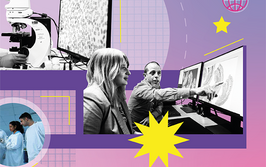Open to the Future
NHS diagnostics must embrace unprecedented openness if AI is to work
Jane Rendall | | Opinion

There is no way any one vendor could ever hope to develop even a fraction of the potential of artificial intelligence (AI) in diagnosing illnesses. It might sound strange for a representative of a UK National Health Service (NHS) diagnostic technology provider to start an opinion piece by saying what such a provider can’t do, but this is a reality that all technology vendors face – and must act on if the NHS is to realize the new “tech vision” the UK’s health secretary launched in October 2018. The Department of Health and Social Care’s vision argues that artificial intelligence has “huge potential to improve diagnosis.” This is absolutely true, but that potential will only be realized if another key facet of the same tech vision – interoperability – extends to the “ologies,” and to the imaging technology on which they rely.
Momentum is building for the NHS to move beyond outdated technology, and if traditional IT vendors are to survive they must support the integration of all sorts of innovations into their products, or else suffer the same fate as the fax machine – and sooner than they might think.
Remarkably, although many companies are thinking collaboratively, we still live in an age where some diagnostic med-tech hardware suppliers force hospitals to purchase proprietary software. Now is the time for suppliers to be open, not archaic. Vendors can’t block the NHS from accessing innovations just because they weren’t the ones to develop them – and the same applies to innovations in the AI space.
Right now, within the NHS and in companies across the globe, people are developing applications and algorithms to tackle real-world problems from detecting deadly diseases sooner to avoiding unnecessary appointments. No single technology vendor could dream up even the smallest percentage of the ideas arising worldwide. Yet, if you were to look across the competitive landscape in NHS diagnostic IT, you would find a plethora of companies obsessed with their own algorithm developments, rather than the wealth of ingenuity they could embrace for their customers.
This isn’t about what any one vendor is developing. The key is for suppliers of traditional technologies, such as the electronic patient record (EPR) or the picture archiving and communication system (PACS), to ensure that they are interoperable and that their customers’ AI applications can plug into the core technologies on which the NHS relies. Hospitals need their core systems to be open platforms for AI, and my colleagues and I believe fundamentally that this is how suppliers can become – and remain – successful. If a hospital wishes to implement a homegrown application into their PACS, they should be able to. If they want to implement an algorithm developed by another vendor or innovator, following necessary due diligence to ensure that application is safe, they need the ability to incorporate it into the PACS. That should be the ethos of any healthcare technology company, so that their platforms can allow AI to flourish and their customers can take advantage of the newest developments.
Making this work means applying AI to the richest possible dataset. That doesn’t necessarily mean sharing data externally, but it certainly necessitates joining together data and imaging across the trust and thinking at the population level. Simply put, enterprise-wide image management is the only way forward. We must break down the barriers between the ologies so that images from a whole host of diagnostic specialties can support diagnoses and become integrated with information from the EPR.
Standards such as Health Level Seven Fast Health Interoperability Resources can be key in enabling this integration, but require willingness from vendors to collaborate, and from the NHS to think differently about a strategy for digitizing images and information. Only then can AI be used to look for patterns in data – patterns that can identify incidental findings that might show the early onset of a disease not originally investigated, or help to determine how a catastrophic event in the emergency room might be avoided. These are real-world problems, but only through a genuine interoperable and open approach from healthcare systems and their suppliers will they be solved.
Managing Director at Sectra, Stansted, UK.




















